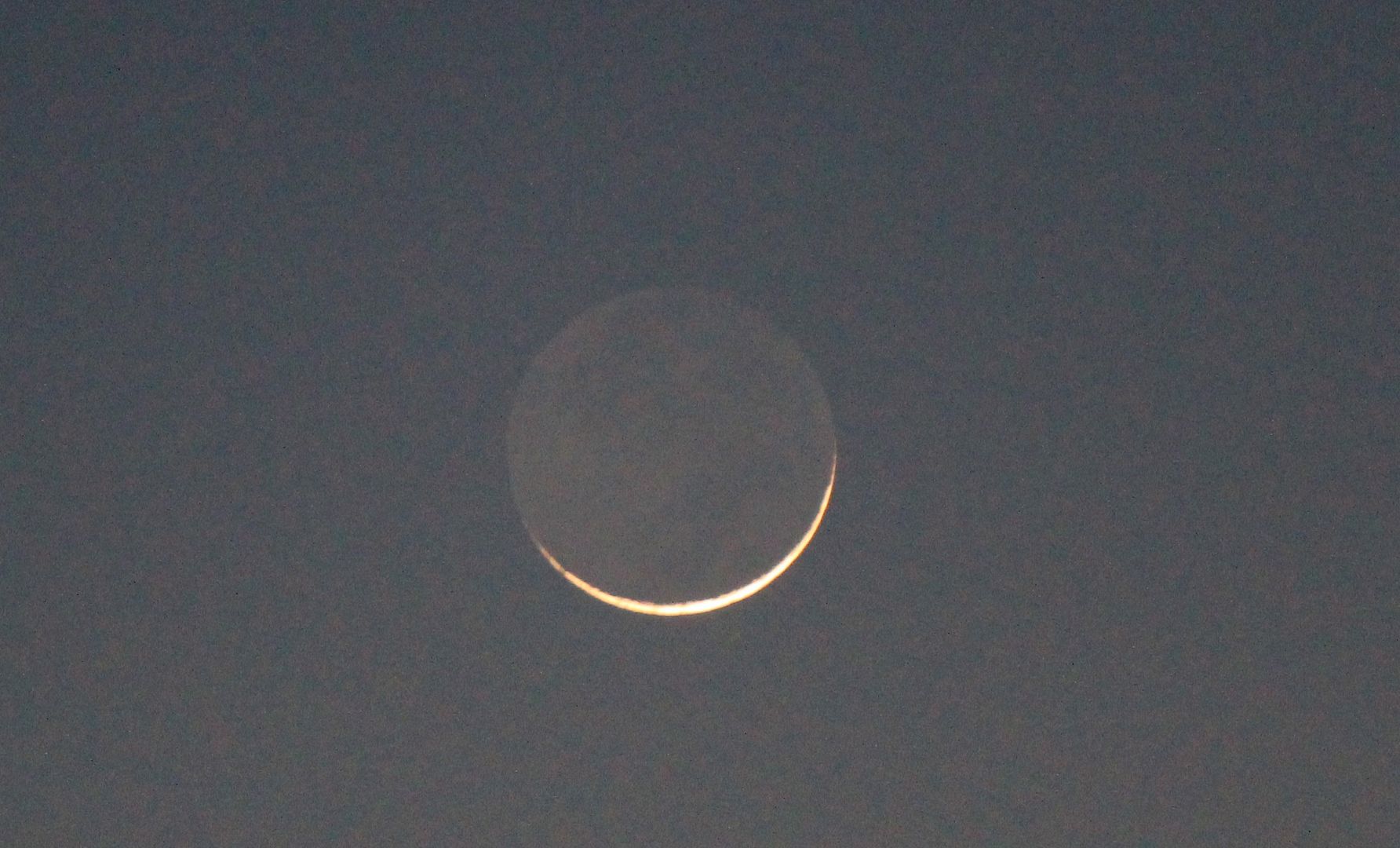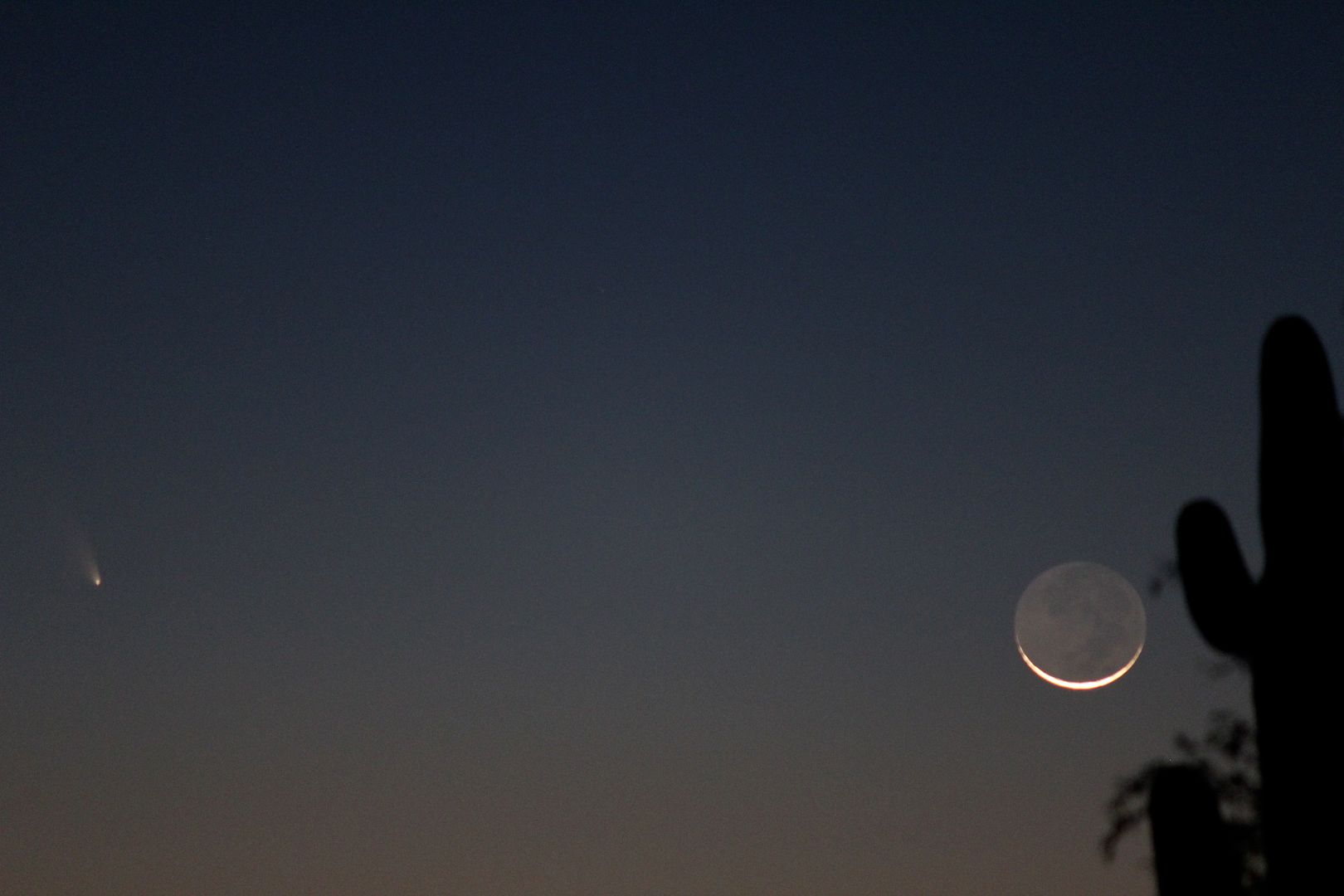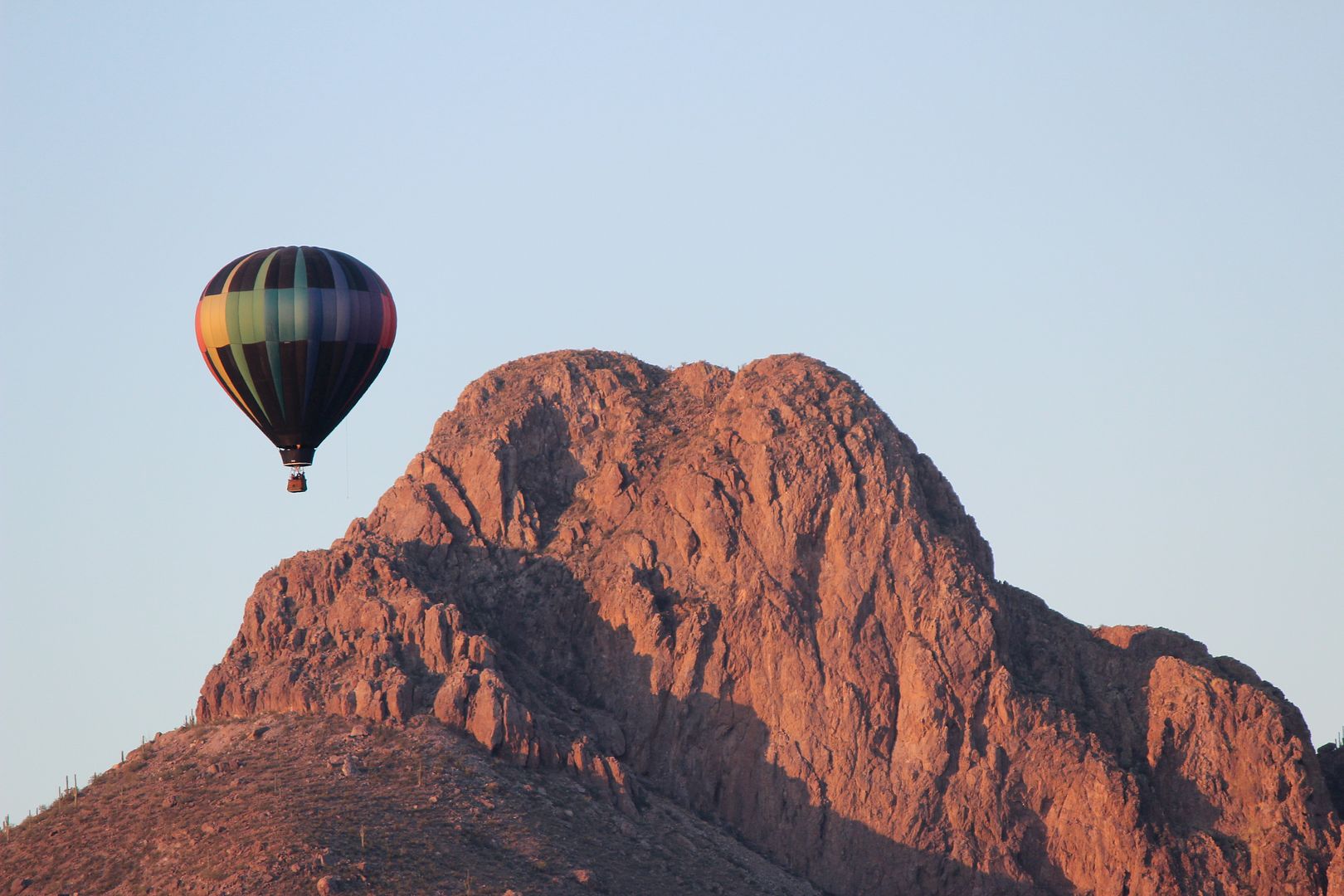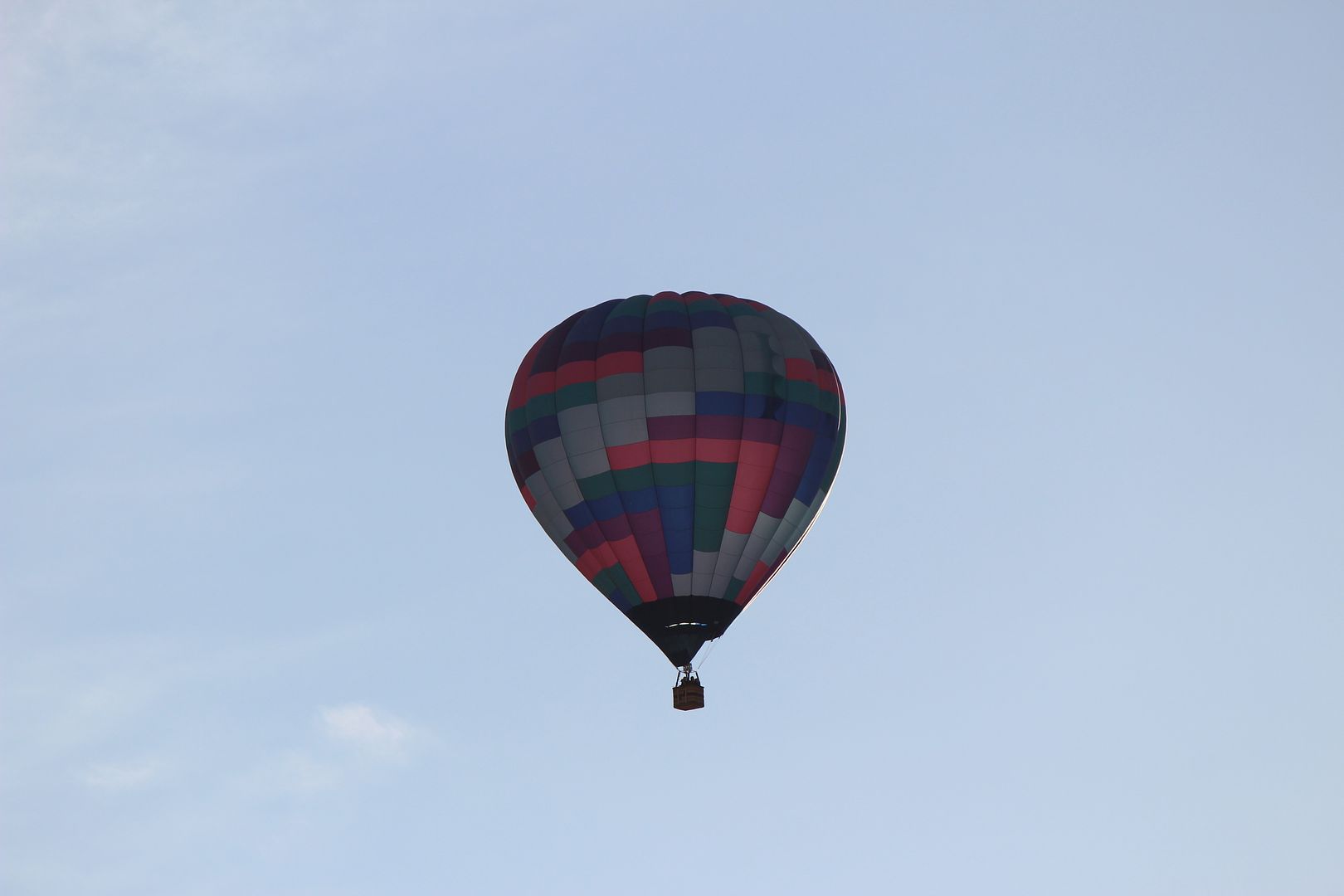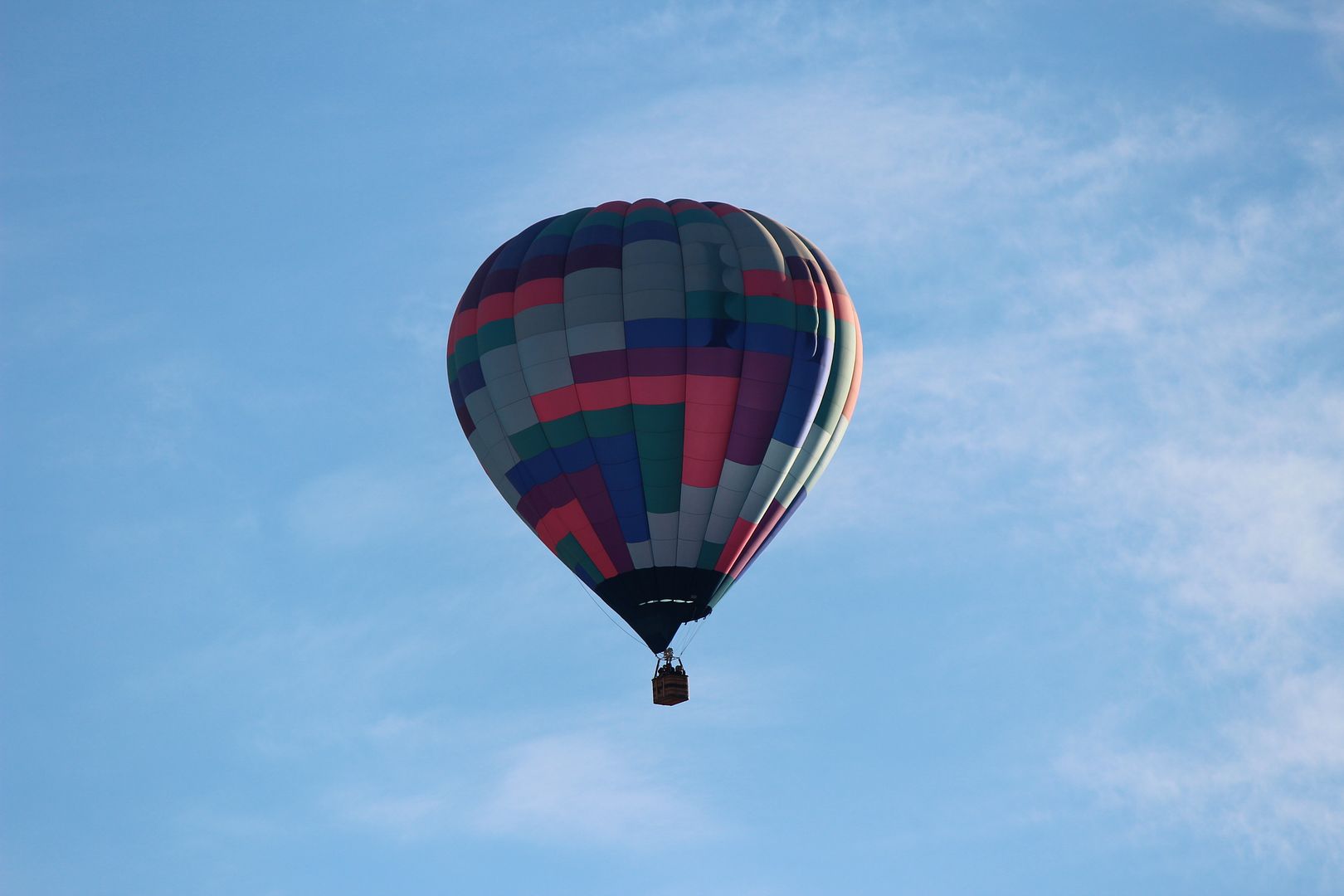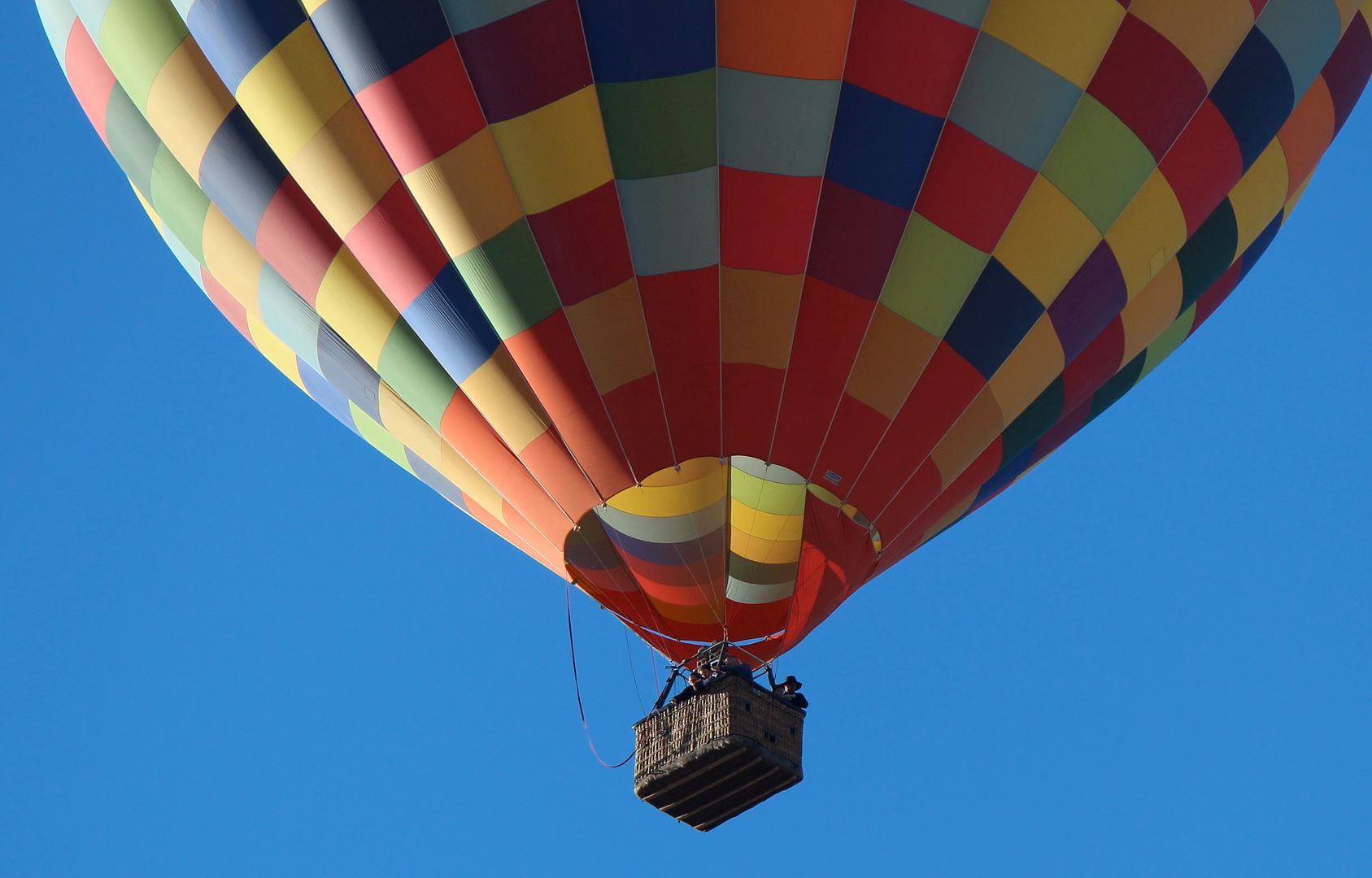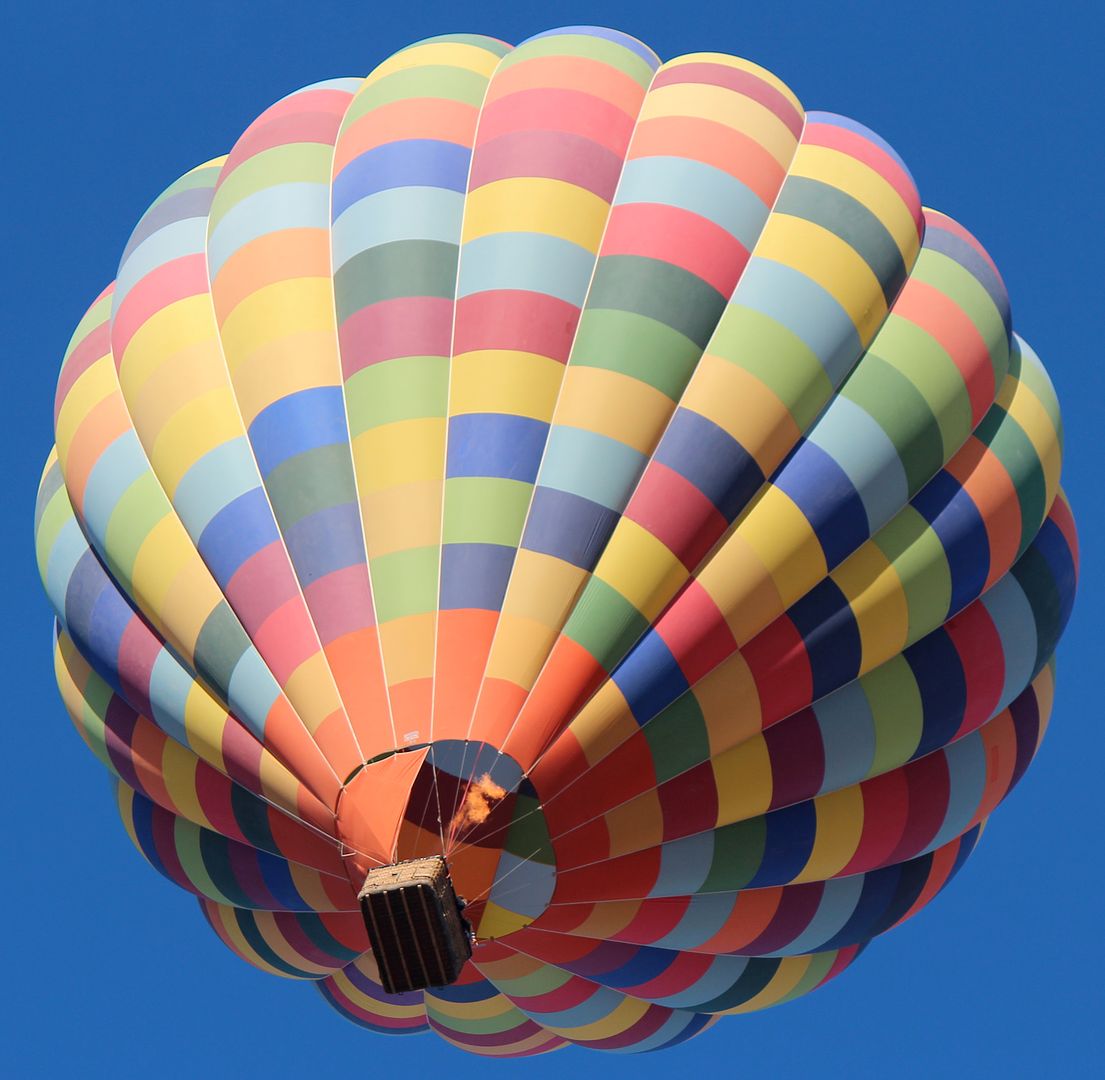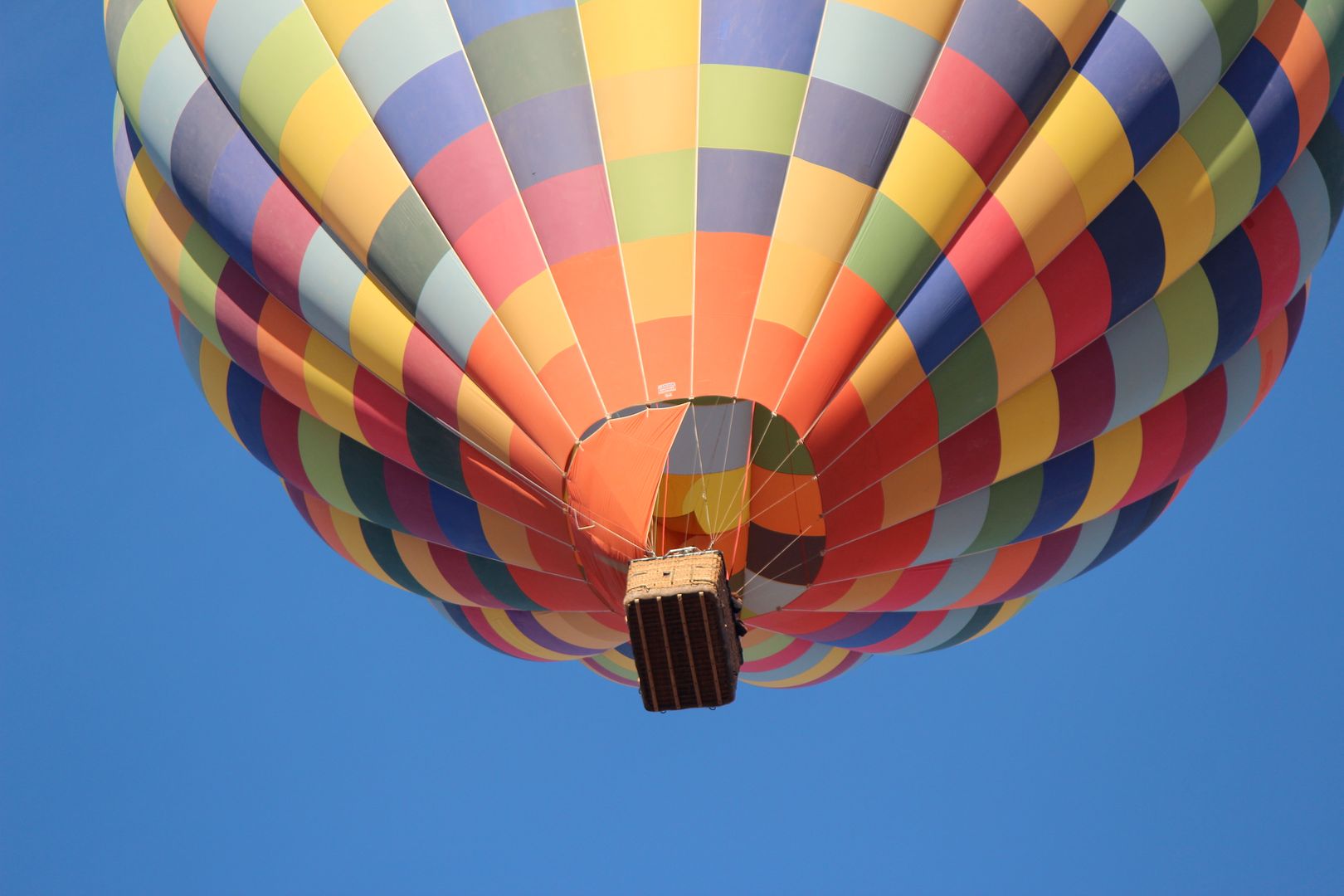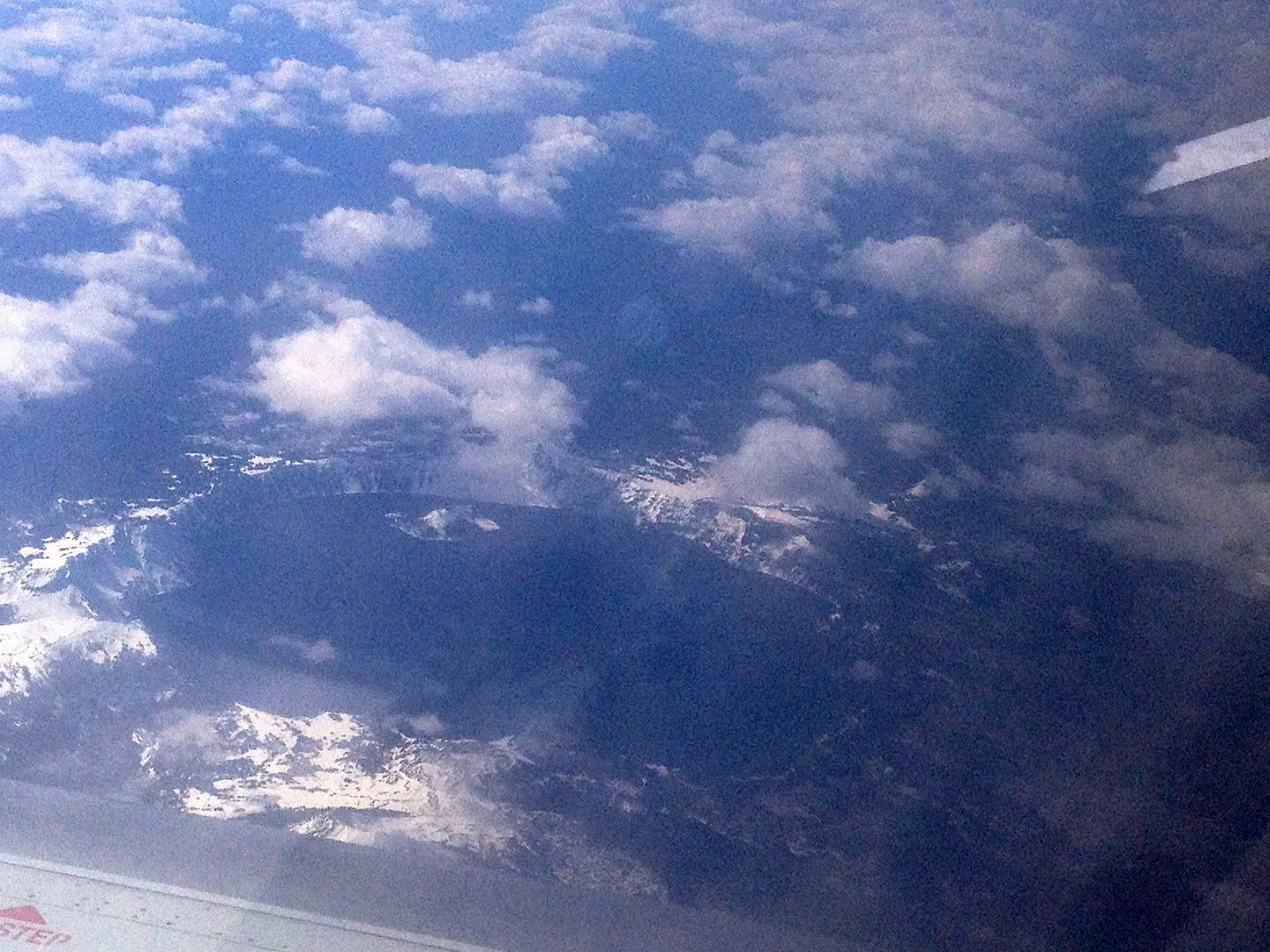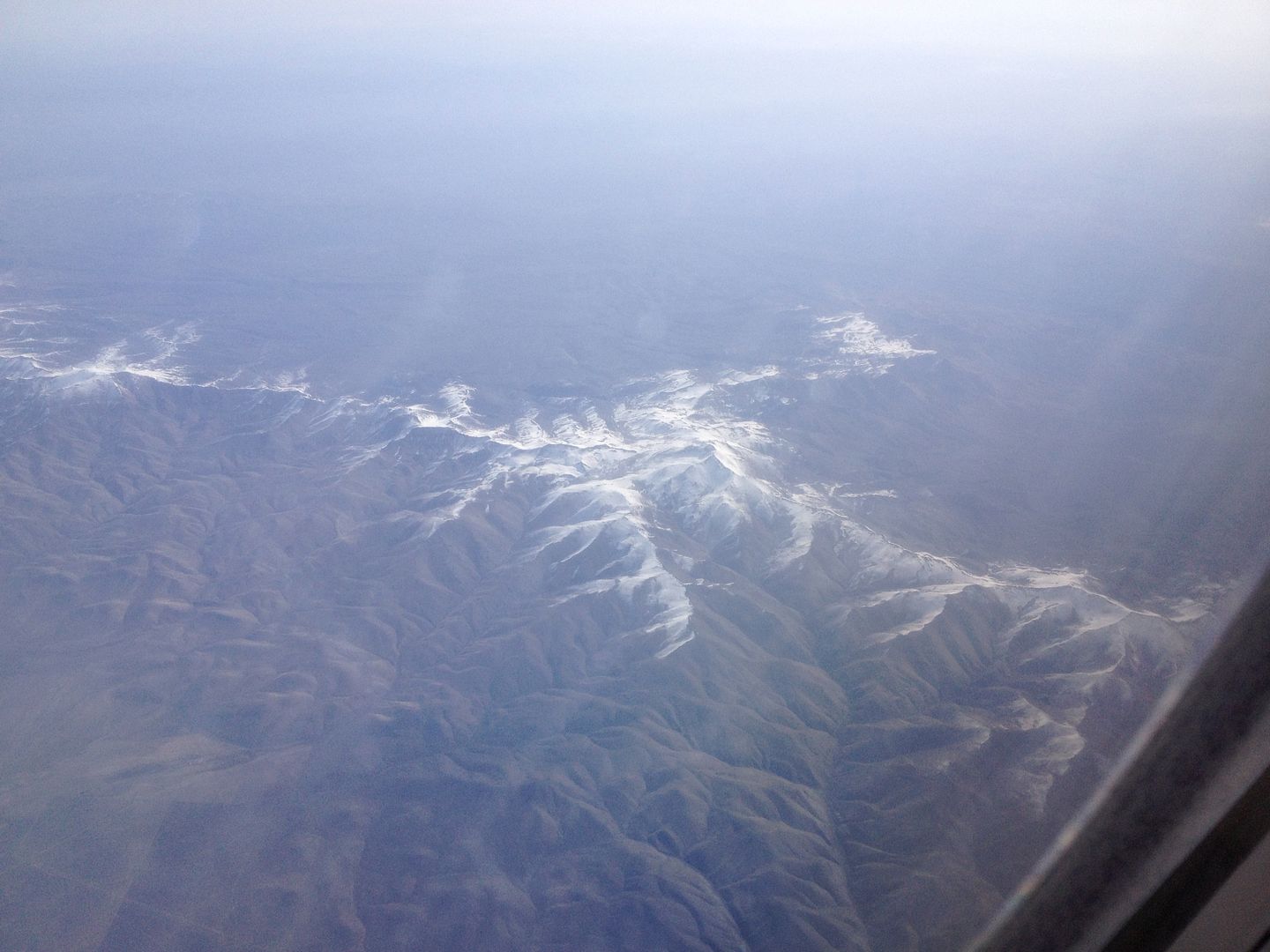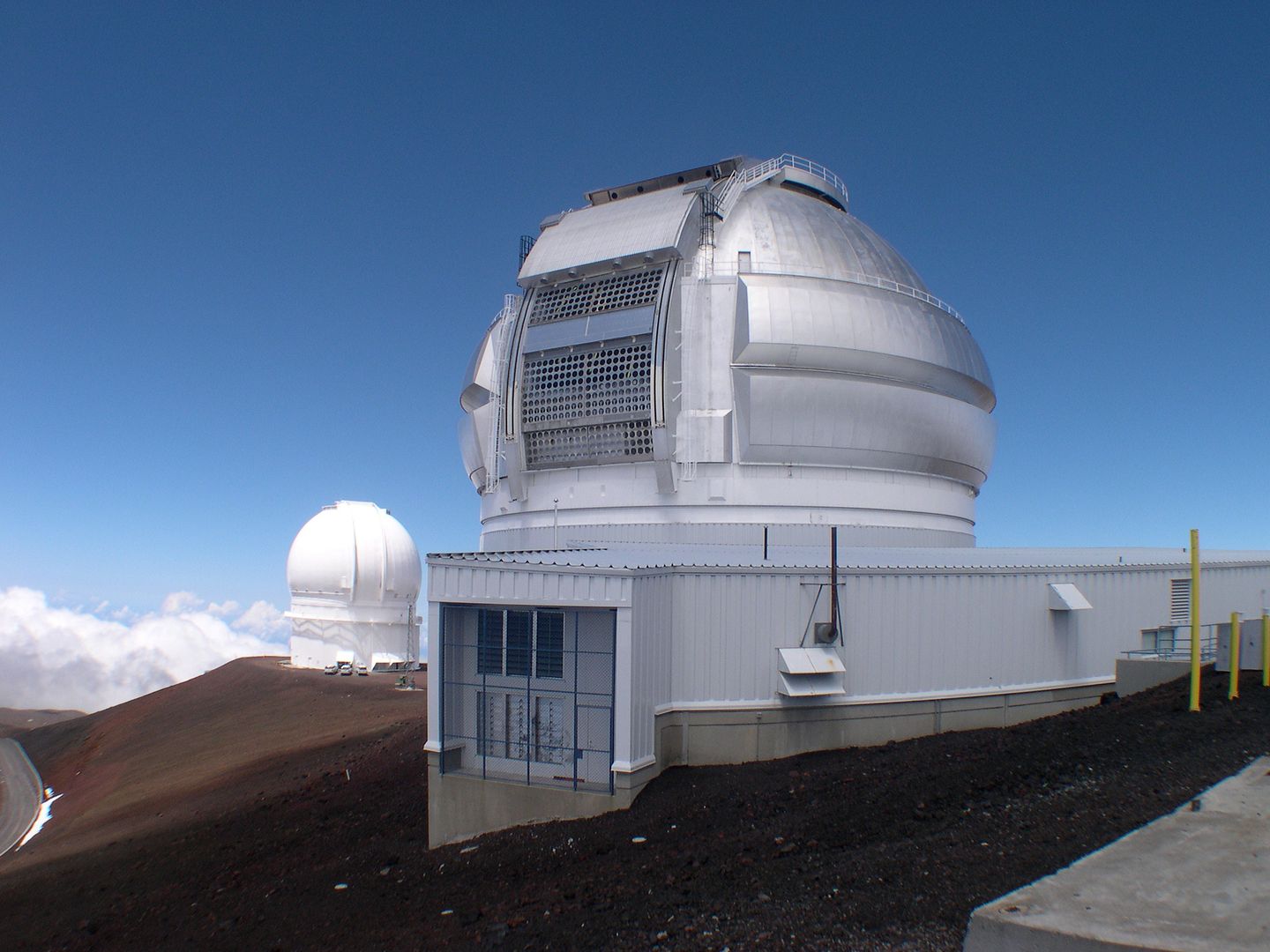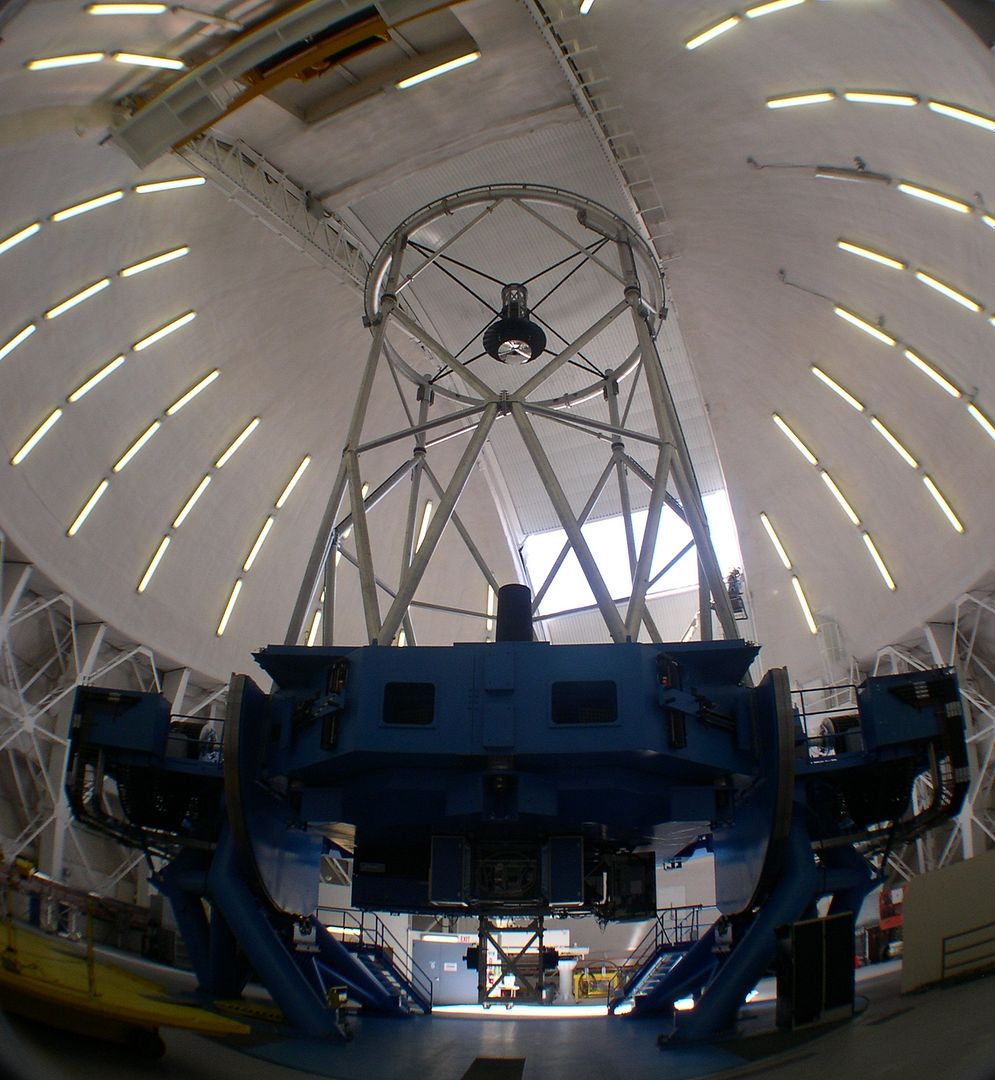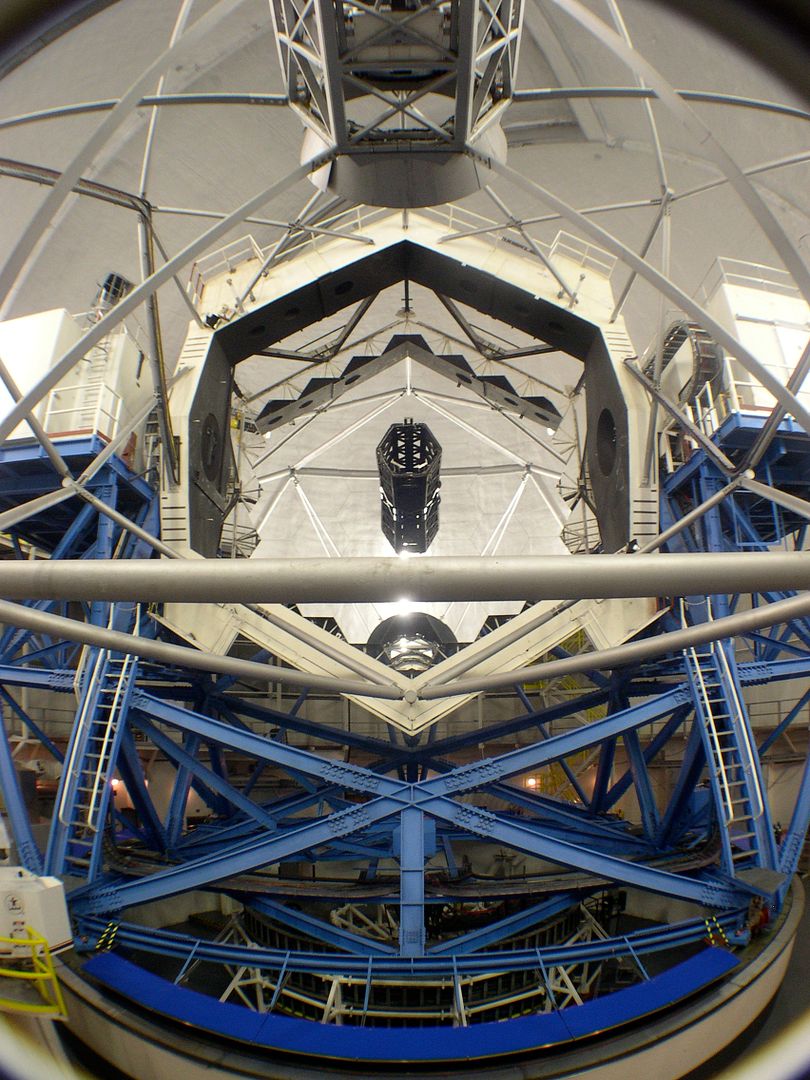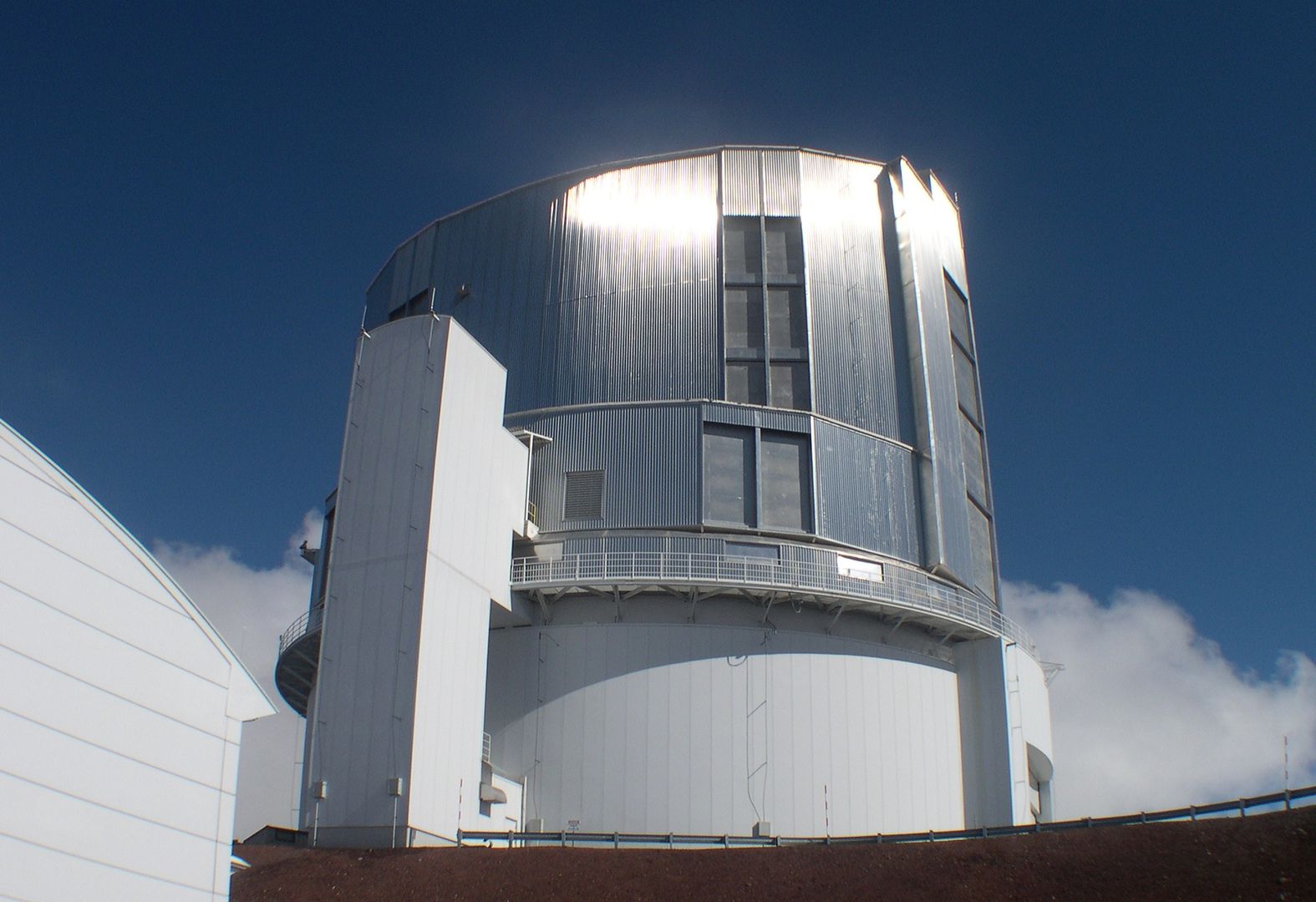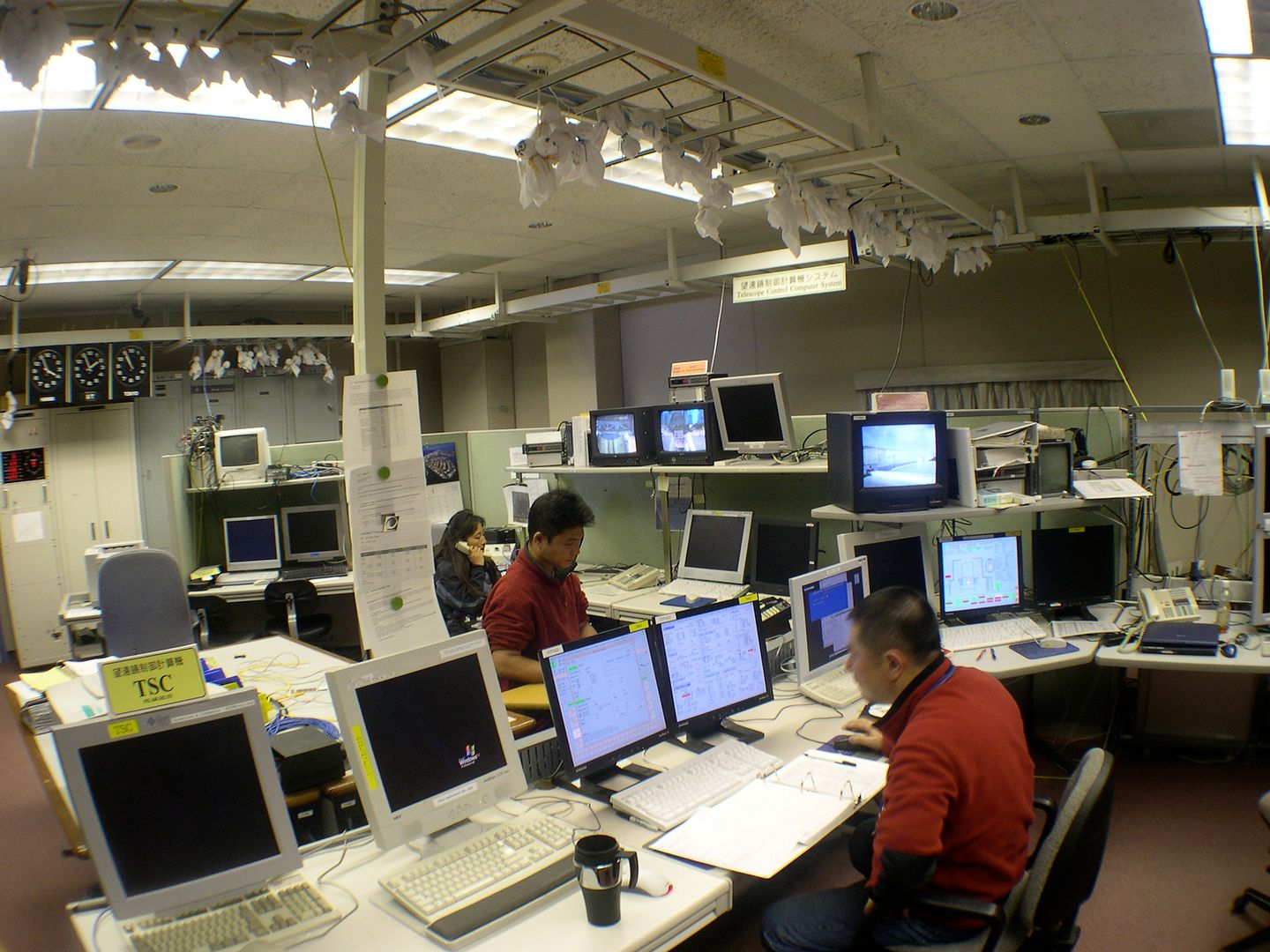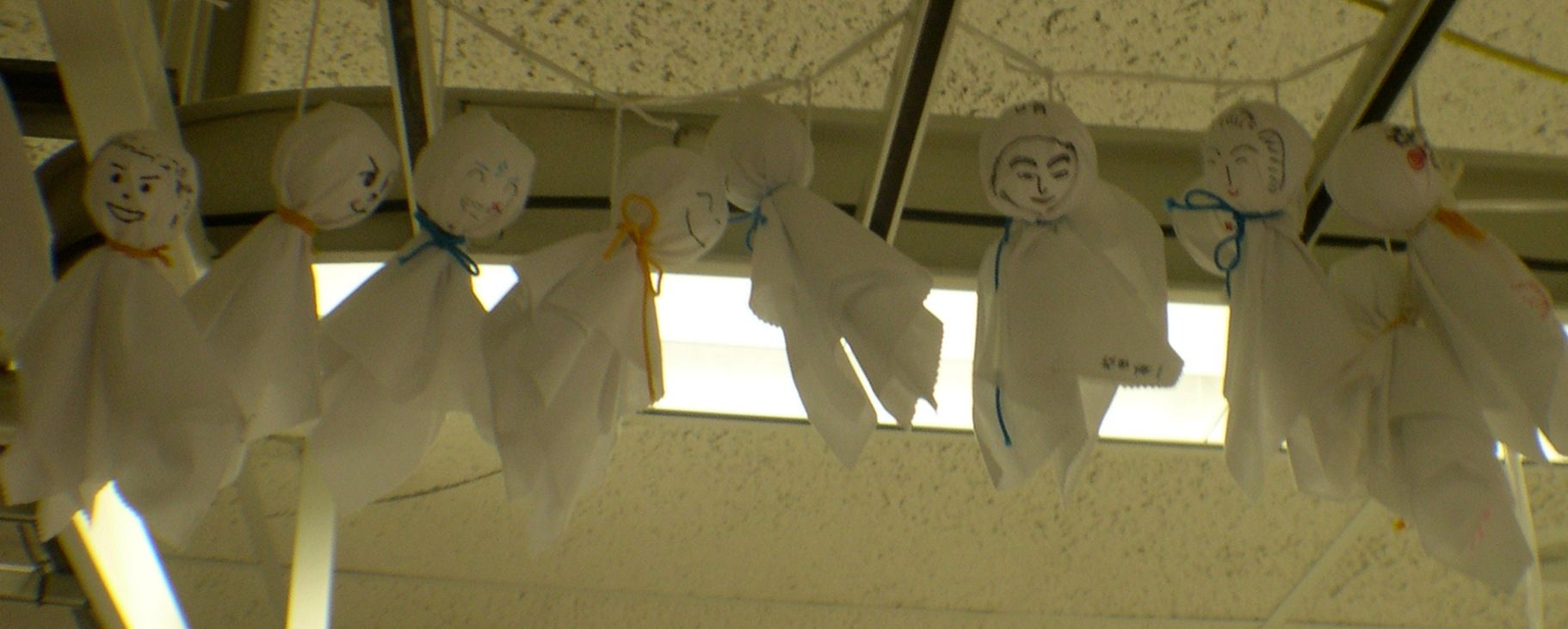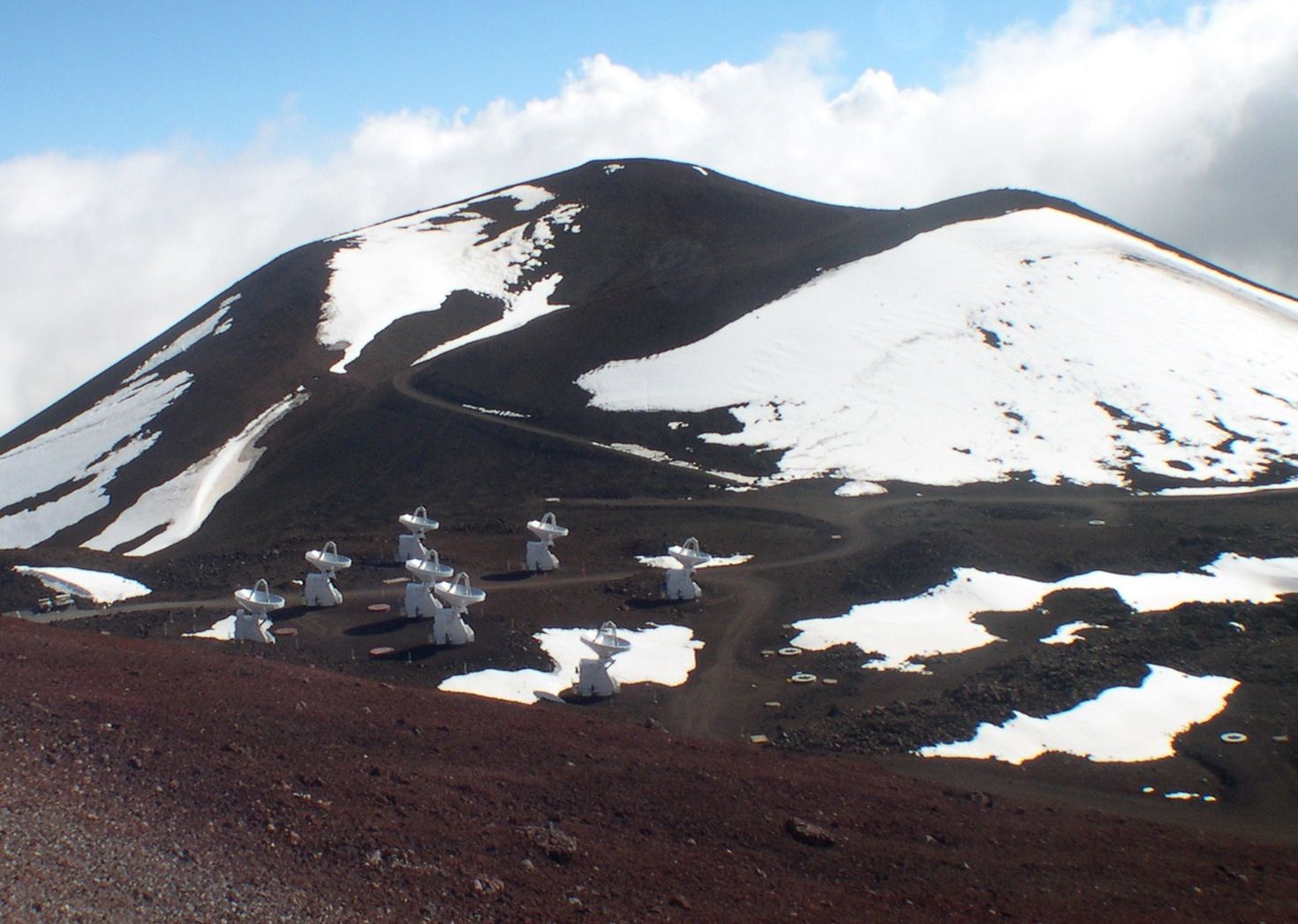Was out for a walk this evening and had to hurry back to grab the camera so that I could grab a shot of tonight's thin crescent Moon.
Seeing low thin crescent hanging in the western sky, reminded me of seeing and photographing Comet PanSTARRS in March of last year.
I don't know about you, but I am ready for another comet to grace our skies.
Monday, March 31, 2014
Sunday, March 30, 2014
Up, Up and Away!
I've taken a lot of photos of the various hot air balloons that drift by my home, this past week I finally had the chance to go up in one.
It was a fine day for sailing. We made arrangements to go up with Southern Arizona Balloon Excursions and they gave us a fine ride.
There were two other balloons heading skyward just ahead of us from our launching site in Avra Valley, AZ. You can see in this shot that they are nearly ready to takeoff while the crew was just getting our balloon, at lower right, ready for hot air.
It was a beautiful Arizona morning. The vivid colors of the balloons stood out against crisp blue sky intermixed with white cirrus clouds.
It was great fun to be up close and personal photographing the first two balloons as they headed skyward and our balloon was prepped to follow.
Finally, our turn was nearing.
Here is the view from in the basket, looking into the heart of the balloon:
Eventually, we were airborne:
I can see my car from here:
and a whole lot more:
even the Moon:
Near the top of this image is the Avra Valley solar farm:
All to soon, it was time to come back down to Earth. Flying in the balloon was a gentle and peaceful as can be. In landing you are at the whim of the winds and the skill of the pilot. Our pilot took us down into a flat area of desert away from major obstacles. The bottom of our basket passed through a low mesquite tree and bounced, sliding a bit as we came to a stop. Here is the skid mark we left on the desert floor:
The flight crew had been chasing us and, once everyone was safely out, quickly began deflating the balloon and folding it up for its next trip.
It was a wonderful trip and I someday I plan to do it again.
It was a fine day for sailing. We made arrangements to go up with Southern Arizona Balloon Excursions and they gave us a fine ride.
There were two other balloons heading skyward just ahead of us from our launching site in Avra Valley, AZ. You can see in this shot that they are nearly ready to takeoff while the crew was just getting our balloon, at lower right, ready for hot air.
It was a beautiful Arizona morning. The vivid colors of the balloons stood out against crisp blue sky intermixed with white cirrus clouds.
It was great fun to be up close and personal photographing the first two balloons as they headed skyward and our balloon was prepped to follow.
Finally, our turn was nearing.
Here is the view from in the basket, looking into the heart of the balloon:
Eventually, we were airborne:
I can see my car from here:
and a whole lot more:
even the Moon:
Near the top of this image is the Avra Valley solar farm:
All to soon, it was time to come back down to Earth. Flying in the balloon was a gentle and peaceful as can be. In landing you are at the whim of the winds and the skill of the pilot. Our pilot took us down into a flat area of desert away from major obstacles. The bottom of our basket passed through a low mesquite tree and bounced, sliding a bit as we came to a stop. Here is the skid mark we left on the desert floor:
The flight crew had been chasing us and, once everyone was safely out, quickly began deflating the balloon and folding it up for its next trip.
It was a wonderful trip and I someday I plan to do it again.
Saturday, March 29, 2014
Signs of Spring and an Iridium Flare
The desert southwest didn't get much of a winter this past season. And while the weather hasn't show much of a change as we've moved into spring, there are still signs of spring on the ground and in the skies.
The palo verde tree (Arizona's official state tree) that lives in our front yard is in full bloom, a sign here in the desert that spring has sprung. I took the shot above last night. Also in the shot are the stars of the Big Dipper, which stands high in the our evening skies in spring.
The reason I was out with my camera was to catch this:
A magnitude -5.8 Iridium flare that was visible in the northern part of the sky. Iridium flares are reflections of sunlight off of satellites that can be some of the brightest things seen in the night sky. I caught this one very near the star of the Little Dipper. That's Polaris, the North Star, just above and left of the flare. Polaris is the star that marks the end of the handle of the dipper.
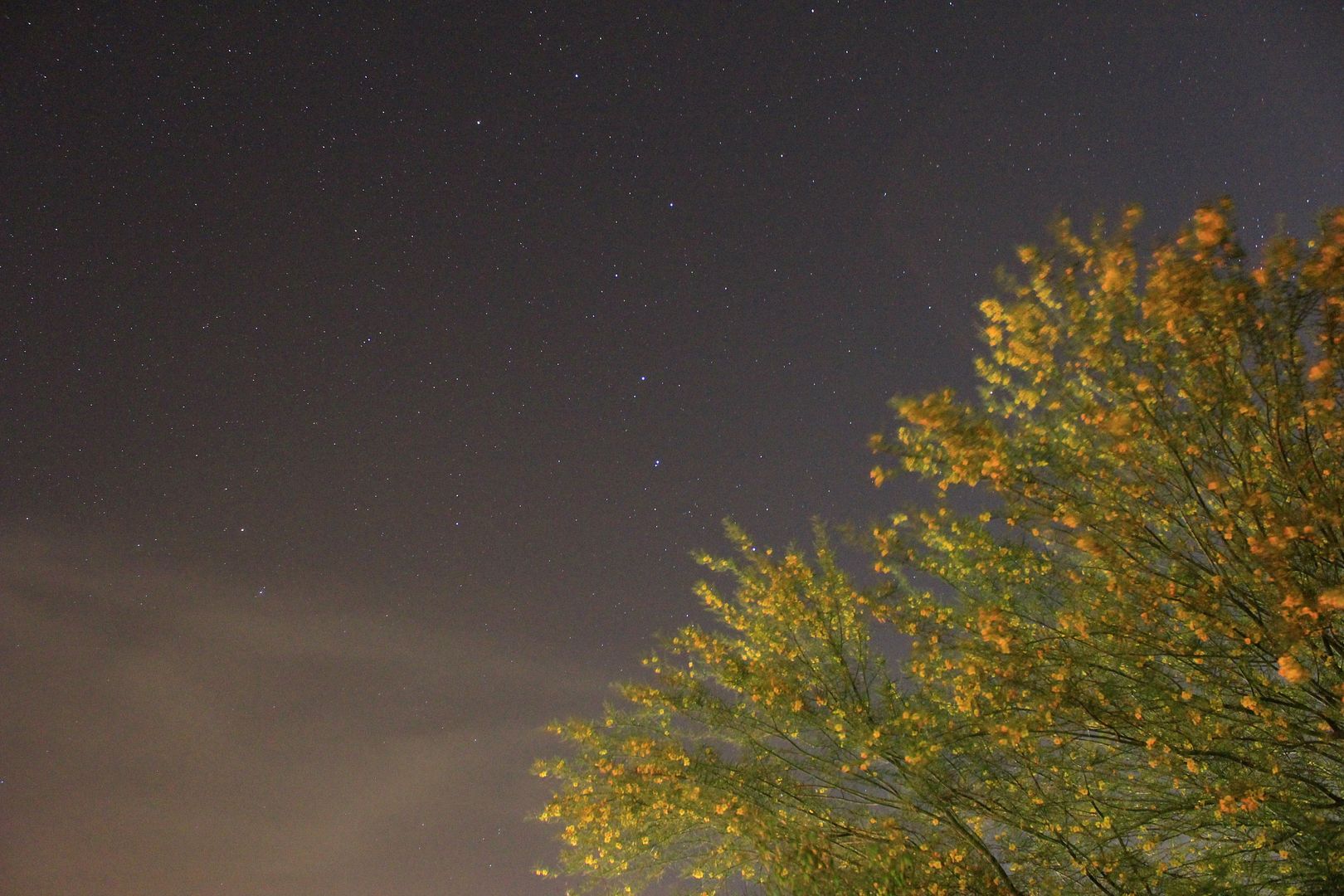 |
| Canon T31, 18mm, 25 seconds, ISO 3200 |
The reason I was out with my camera was to catch this:
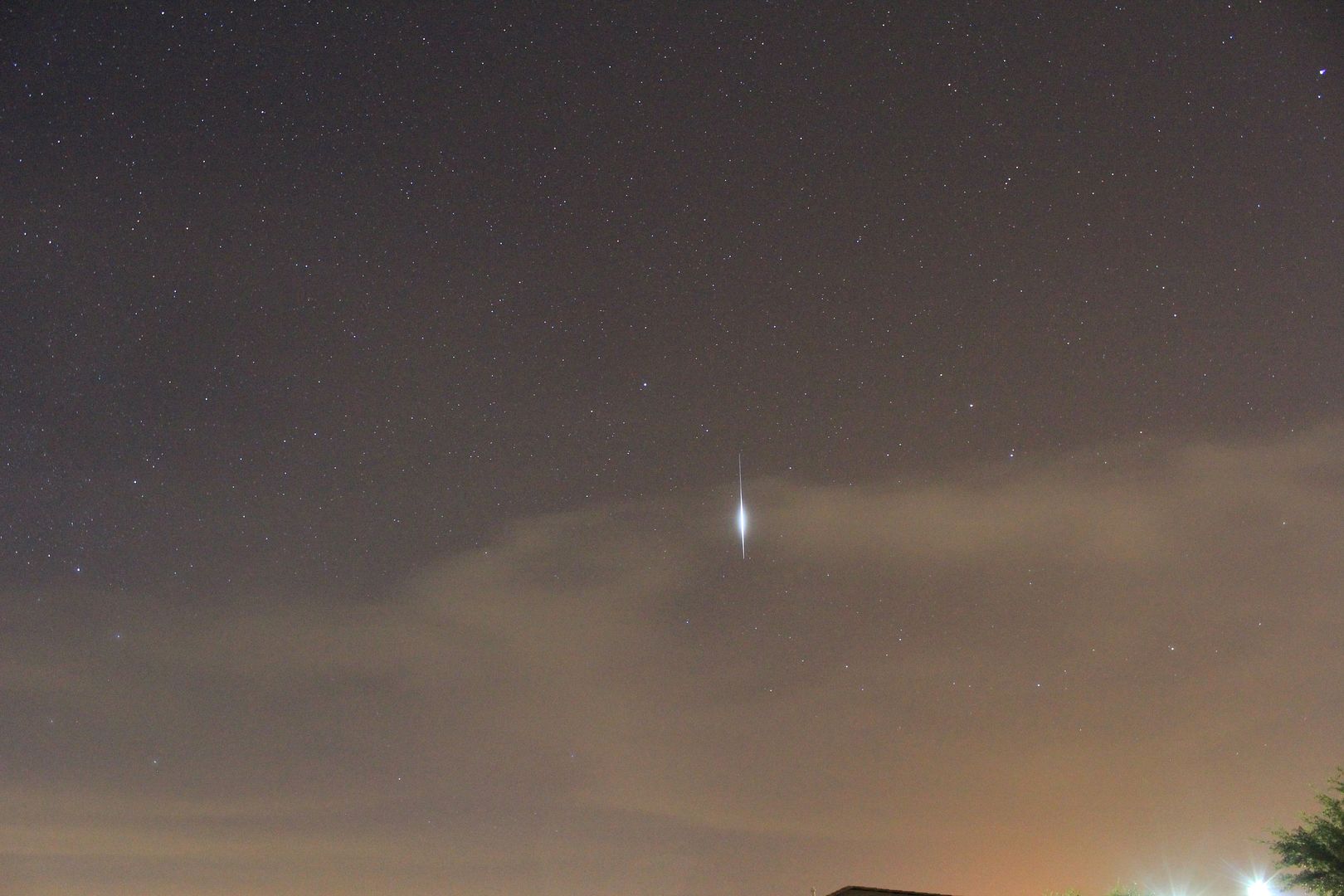 |
| Canon T31, 18mm 30 seconds, ISO 3200 |
Thursday, March 27, 2014
The Moon and Venus: Together again
In case you missed it, here is this morning's view of the Moon and Venus.
Seeing them paired together in the sky like that makes for a nice way to start the day.
Seeing them paired together in the sky like that makes for a nice way to start the day.
Saturday, March 22, 2014
A Three Balloon Morning
There was quite the show this morning, the first Saturday of spring, from the backyard. There were three hot air balloons that made relatively close passes to my home.
The first balloon lifted off just before sunrise. It glided past in the west, passing in front of rugged Sombrero Peak of the Tucson Mountains.
The second balloon was to the east in nearly the same direction as the Sun.
I was hoping that it might pass directly in front of the Sun from my vantage point forming a balloonar eclipse, but alas, it was not to be. As it glided further northward it moved out of the Sun's glare and made a nice appearance in the sky.
The third balloon was on a course to pass nearly directly overhead from my vantage point.
While it wasn't exactly at my zenith, it did indeed make a close encounter.
It is always nice when you can look up and into the heart of the hot air balloon as they unleash the fire, giving it more lift.
Certainly it was a fine morning for sailing.
The first balloon lifted off just before sunrise. It glided past in the west, passing in front of rugged Sombrero Peak of the Tucson Mountains.
The second balloon was to the east in nearly the same direction as the Sun.
I was hoping that it might pass directly in front of the Sun from my vantage point forming a balloonar eclipse, but alas, it was not to be. As it glided further northward it moved out of the Sun's glare and made a nice appearance in the sky.
The third balloon was on a course to pass nearly directly overhead from my vantage point.
While it wasn't exactly at my zenith, it did indeed make a close encounter.
It is always nice when you can look up and into the heart of the hot air balloon as they unleash the fire, giving it more lift.
Certainly it was a fine morning for sailing.
Sunday, March 16, 2014
The Window Seat
When flying it sure it nice to have lots of leg room. That makes the aisle seat a very attractive choice, but the window seat can offer some pretty amazing views that are tough to pass up. I just took a whirlwind trip to Portland Oregon and back and very much enjoyed looking out the window.
On the way up I unfortunately sat at a really scratched up window that also had a fair amount of condensation, which later became ice, between the window's layers. It didn't offer the best of views, although I did manage to see Crater Lake National Park and snap this shot of it with my phone:
If you look closely, near the bottom of the photo you can see the big, round caldera of Crater Lake and also Wizard Island within it. I was fortunate enough to be able to visit CLNP in person in the summer of 2008. Here's how it looked back then:
It certainly is a beautiful place.
For this morning's flight back home I had the window seat again and a better window. I tried some more photography with my phone. I took some still shots like this one of some snow-covered mountains:
I also tried out the free Motion Pictures app for my iPhone, allowing me to make some time-lapse movies of the views.
This was shot with one frame every second and 30 frames are in each second of the resulting video. The app is very easy to use. I'll have to find some other interesting ways to make use of it. Here's another short video shot looking out the air plane window with the same settings:
You'll notice that I didn't do the best of jobs holding the phone very steady. When we flew over the Grand Canyon I was even worse at holding the phone steady. So instead of subjecting you to that bumpy video, I'll just post a still:
I've got a some more trips coming up soon. If I get any interesting videos, I'll be sure to post them here.
On the way up I unfortunately sat at a really scratched up window that also had a fair amount of condensation, which later became ice, between the window's layers. It didn't offer the best of views, although I did manage to see Crater Lake National Park and snap this shot of it with my phone:
If you look closely, near the bottom of the photo you can see the big, round caldera of Crater Lake and also Wizard Island within it. I was fortunate enough to be able to visit CLNP in person in the summer of 2008. Here's how it looked back then:
It certainly is a beautiful place.
For this morning's flight back home I had the window seat again and a better window. I tried some more photography with my phone. I took some still shots like this one of some snow-covered mountains:
I also tried out the free Motion Pictures app for my iPhone, allowing me to make some time-lapse movies of the views.
This was shot with one frame every second and 30 frames are in each second of the resulting video. The app is very easy to use. I'll have to find some other interesting ways to make use of it. Here's another short video shot looking out the air plane window with the same settings:
You'll notice that I didn't do the best of jobs holding the phone very steady. When we flew over the Grand Canyon I was even worse at holding the phone steady. So instead of subjecting you to that bumpy video, I'll just post a still:
I've got a some more trips coming up soon. If I get any interesting videos, I'll be sure to post them here.
Saturday, March 8, 2014
Telescope Tourist: Mauna Kea Observatory
It has been nearly ten years since I made my first visit to the summit of Mauna Kea on the Big Island of Hawai'i. There is an amazing array of world-class telescopes on the site. At an elevation of 4,205 meters (13,796 feet) above sea level it is one of the world's best observing sites for astronomy.
That's me with (from left to right) the domes of the 3.6-meter Canada-France-Hawaii Telescope, 8.1- meter Gemini North, and the University of Hawaii 2.2-meter telescopes. Back in 2004 I had a behind-the-scenes tour that gave me a close look at five of the telescopes on the mountaintop.
This is the dome of the Gemini North Telescope with the dome of the Canada-France-Hawaii Telescope behind it to the left. This is one of two twin telescopes, with the second being located in Chile. Together, the pair can observe virtually the entire celestial sphere.
Here's the view from inside the dome. Like all of the big telescopes built since the 1990s it has an altitude-azimuth mount, giving it a very different look from equatorial mounted telescopes like Palomar's Hale Telescope or Mauna Kea's Canada-France-Hawaii Telescope.
There was some dome maintenance taking place during my visit. You can notice that it is partially open. Alas, my visit with Gemini was pretty short but it was a pleasure seeing one of the giant telescopes of the modern age, one of several such telescopes on Mauna Kea.
From there I went on to visit the two telescopes of the W.M. Keck Observatory.
The photo above show the giant, segmented primary mirror of one of the two Keck Telescopes. The primary mirror is composed of 36 hexagonal segments, each 1.8 meters (6 feet) across. Together they work as one mirror 10 meters in diameter. The light reflects off of the primary mirror to a secondary mirror (at top) and then back down to a third mirror (black area near the center) and then off to one of the two white areas on either side at what is called the Nasmyth focus where it is recorded by one of the many scientific instruments.
Here's how the telescope looks standing straight up:
The mirrors are quite thin, just 7.5 cm thick. As the telescope is used for astronomy the position each of each of the mirror segments is monitored and adjusted in real time to ensure proper focus of the telescope. This is called active optics -- not to be confused with adaptive optics, which corrects distortions in light caused by the atmosphere. The Keck Telescopes make use of adaptive optics too (as does Gemini), but not by controlling the shape of the primary mirror. Those corrections happen in one of the Nasmyth instruments.
In the photo above you can see the thin primary mirror segments and the network of active optics controls underneath them.
Standing in the presence of the Keck telescopes, I was struck by how little they had in common with the elder, formerly world's largest telescope at Palomar. The Kecks each individually are twice as large (with four times the light gathering power of the Hale), yet weigh far less. Their mirrors are faster (more steeply curved) so as to bring light to focus in a shorter distance, meaning the telescopes don't have to be as long and the domes can be smaller. This design keeps costs down, maximizing scientific the return on the dollar. Because of the telescope's framework design and the domes being as small as they can be, there isn't the same sense of space and grandeur that you feel in the presence of a telescope like the Hale. Yet they are still very impressive in their own right. The Keck telescopes have done much to probe the vastness of the universe.
After visiting Keck, I had the chance to see the National Optical Observatory of Japan's 8.2-meter Subaru Telescope. Here I am with the Subaru Telescope:
It is a versatile telescope that can bring light to focus in one of three different places: Nasmyth, Cassegrain (bottom) or prime (top). Here's a better shot of the telescope:
Notice that there is an instrument package hanging underneath the telescope at the Cassegrain focus and the bright secondary mirror at top (in the center of the blue ring). In this configuration light reflects off of the primary mirror, back up to the secondary mirror and through a hole in the primary mirror down to the instrument package.
While I was at Subaru I had the opportunity to visit the room where the telescope is controlled. Typically, I don't post photos of such places as they tend to look like boring rooms filled with computers. But Subaru's control room had something I had never seen before.
Take a look at what is hanging from the ceiling:
Those are called teru teru bozu dolls. They are handmade dolls that in the Japanese culture reportedly have the power to bring good weather. Yes, even on Mauna Kea there can be bad weather. I don't know much about the Japanese culture but it was fascinating to see these hanging in this high-tech environment.
My last stop brought me to one of the older and smaller telescopes on the site, the 2.2-meter (88 inch) Telescope. This telescope was established in 1970 and helped to pave the way for the larger instruments that since joined it on the mountain.
Before I left the mountaintop I also had a distant view of the Submillimeter Array:
Finally, while I was in Hawai'i I also had the opportunity to present at AstroDay in Hilo, a major astronomy public outreach event.
I surprised more than a few people there by representing an observatory from the mainland. Curiously, I was set up right next to a booth for the International Dark-Sky Association where I now work.
This year's AstroDay will be held on May 3rd. Here's a Facebook page that describes this year's event. If you are going to be on the Big Island that day, you should make plans to attend.
If you can't make the visit to Mauna Kea, I encourage you to explore the links I placed in this post. You might also be interested in seeing some of the many webcams that are on the mountain. When the daytime weather is nice there are great views of the various domes. At night there can also be some great views of the night sky from the CFHT Cloudcam.
I hope you've enjoyed this quick look at some of the best astronomical telescopes in the world. I still have a few more observatories to share as a part of my Telescope Tourist posts. Hopefully, I'll have the time to post more of them soon.
That's me with (from left to right) the domes of the 3.6-meter Canada-France-Hawaii Telescope, 8.1- meter Gemini North, and the University of Hawaii 2.2-meter telescopes. Back in 2004 I had a behind-the-scenes tour that gave me a close look at five of the telescopes on the mountaintop.
This is the dome of the Gemini North Telescope with the dome of the Canada-France-Hawaii Telescope behind it to the left. This is one of two twin telescopes, with the second being located in Chile. Together, the pair can observe virtually the entire celestial sphere.
Here's the view from inside the dome. Like all of the big telescopes built since the 1990s it has an altitude-azimuth mount, giving it a very different look from equatorial mounted telescopes like Palomar's Hale Telescope or Mauna Kea's Canada-France-Hawaii Telescope.
There was some dome maintenance taking place during my visit. You can notice that it is partially open. Alas, my visit with Gemini was pretty short but it was a pleasure seeing one of the giant telescopes of the modern age, one of several such telescopes on Mauna Kea.
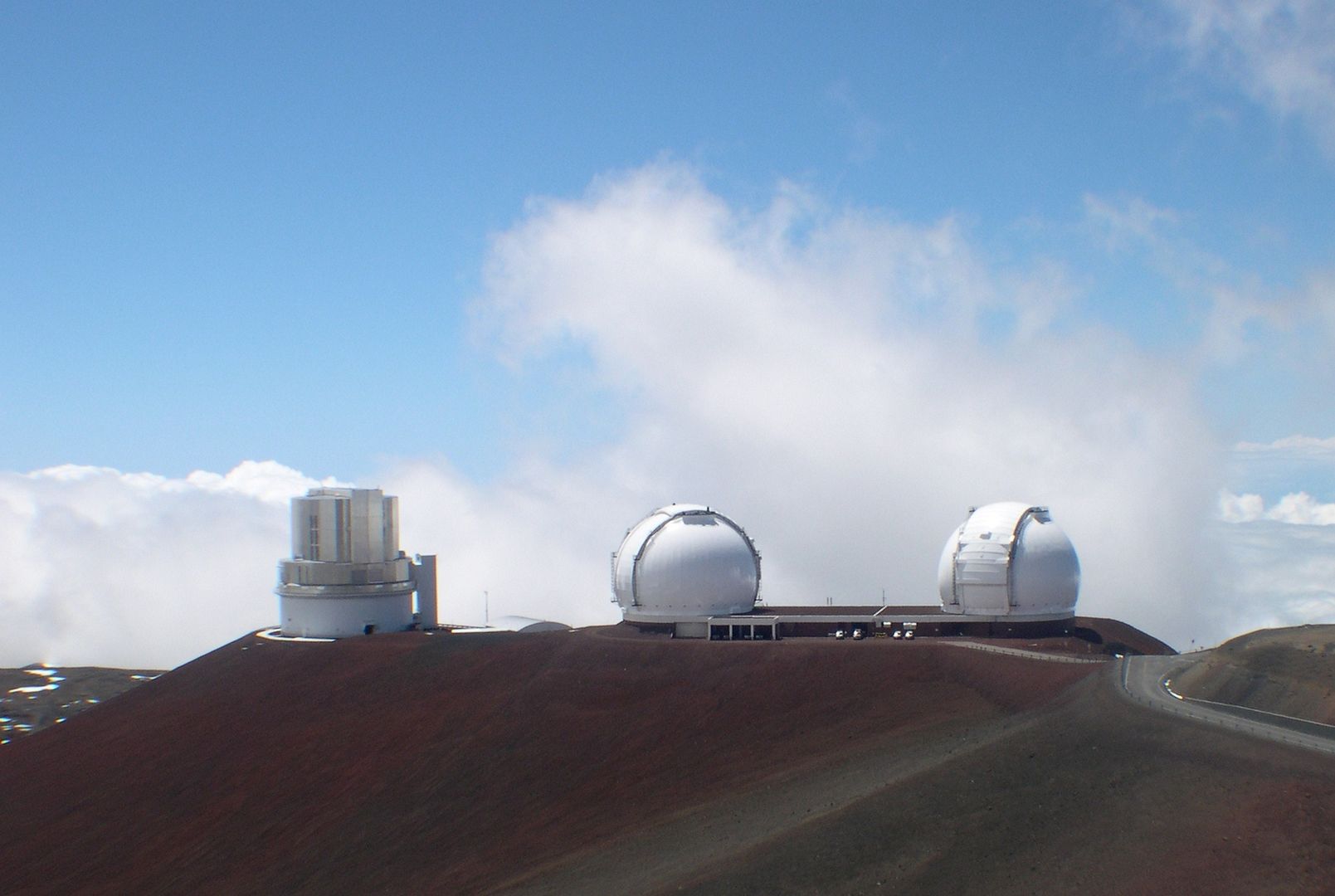 |
| Subaru, Keck I and Keck II |
The photo above show the giant, segmented primary mirror of one of the two Keck Telescopes. The primary mirror is composed of 36 hexagonal segments, each 1.8 meters (6 feet) across. Together they work as one mirror 10 meters in diameter. The light reflects off of the primary mirror to a secondary mirror (at top) and then back down to a third mirror (black area near the center) and then off to one of the two white areas on either side at what is called the Nasmyth focus where it is recorded by one of the many scientific instruments.
Here's how the telescope looks standing straight up:
The mirrors are quite thin, just 7.5 cm thick. As the telescope is used for astronomy the position each of each of the mirror segments is monitored and adjusted in real time to ensure proper focus of the telescope. This is called active optics -- not to be confused with adaptive optics, which corrects distortions in light caused by the atmosphere. The Keck Telescopes make use of adaptive optics too (as does Gemini), but not by controlling the shape of the primary mirror. Those corrections happen in one of the Nasmyth instruments.
In the photo above you can see the thin primary mirror segments and the network of active optics controls underneath them.
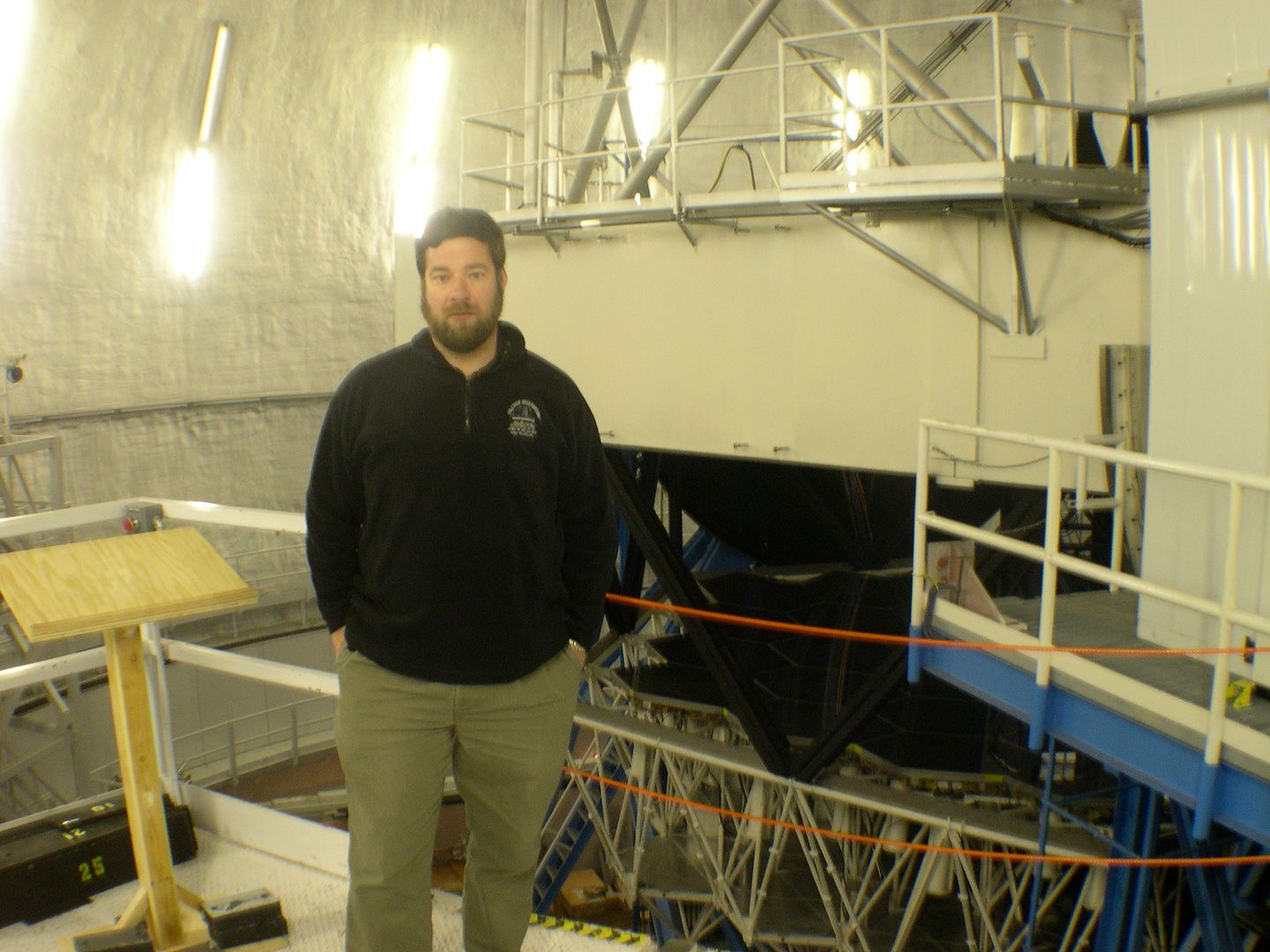 |
| Me, with Keck II. Maybe next time I'll smile. |
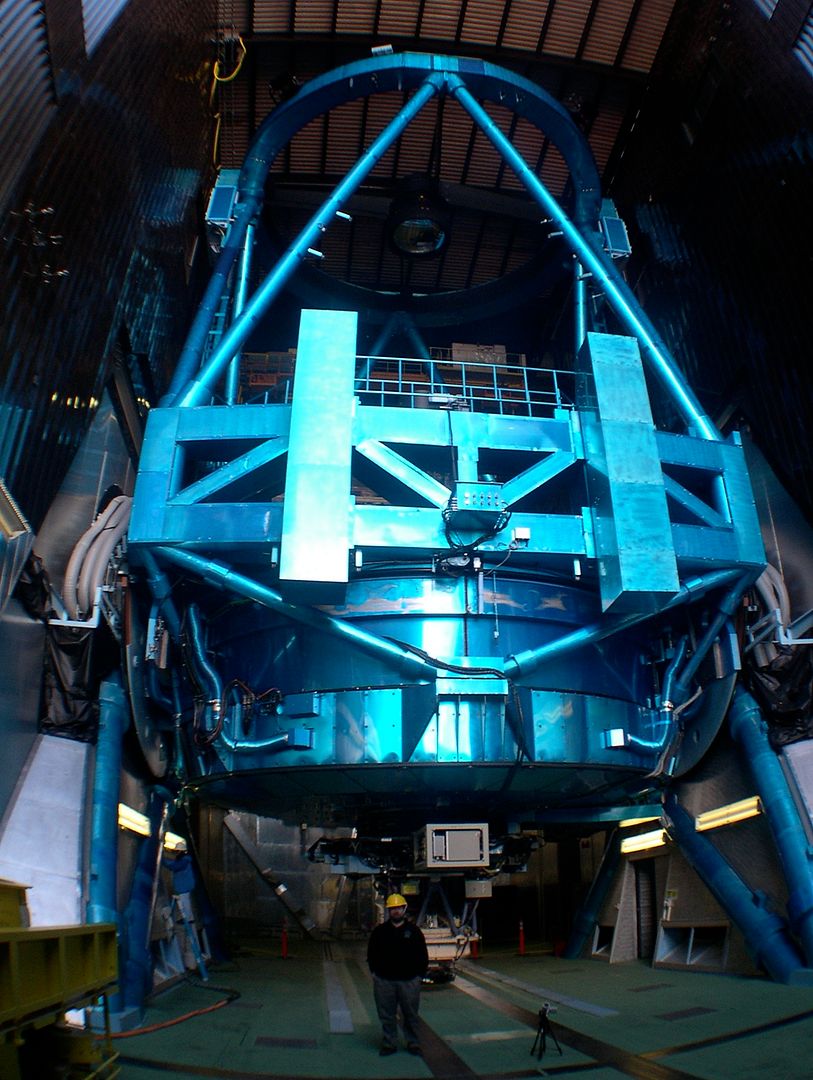 |
| Standing under the Subaru |
Notice that there is an instrument package hanging underneath the telescope at the Cassegrain focus and the bright secondary mirror at top (in the center of the blue ring). In this configuration light reflects off of the primary mirror, back up to the secondary mirror and through a hole in the primary mirror down to the instrument package.
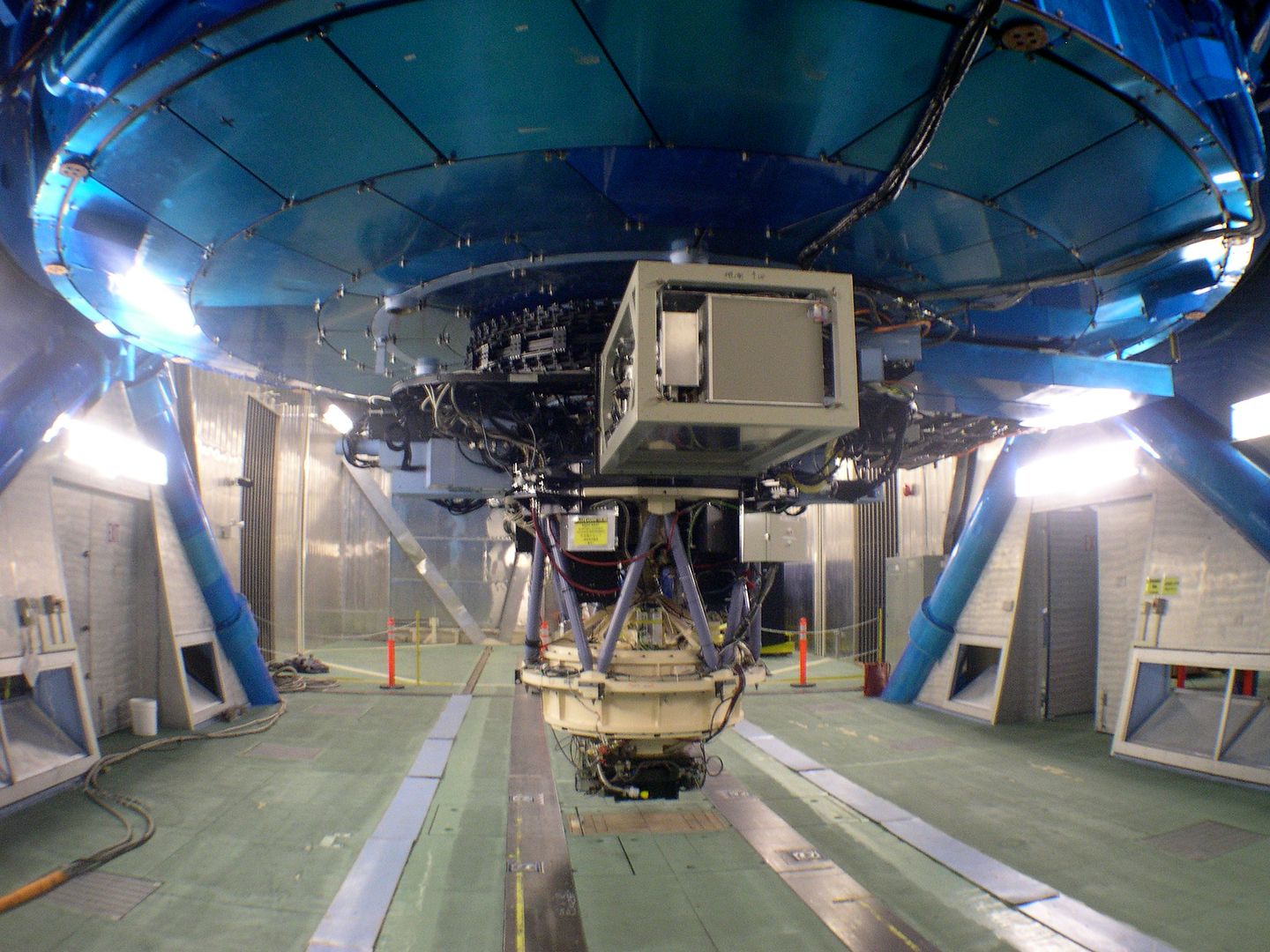 |
| Subaru's Faint Object Camera And Spectrograph |
Take a look at what is hanging from the ceiling:
Those are called teru teru bozu dolls. They are handmade dolls that in the Japanese culture reportedly have the power to bring good weather. Yes, even on Mauna Kea there can be bad weather. I don't know much about the Japanese culture but it was fascinating to see these hanging in this high-tech environment.
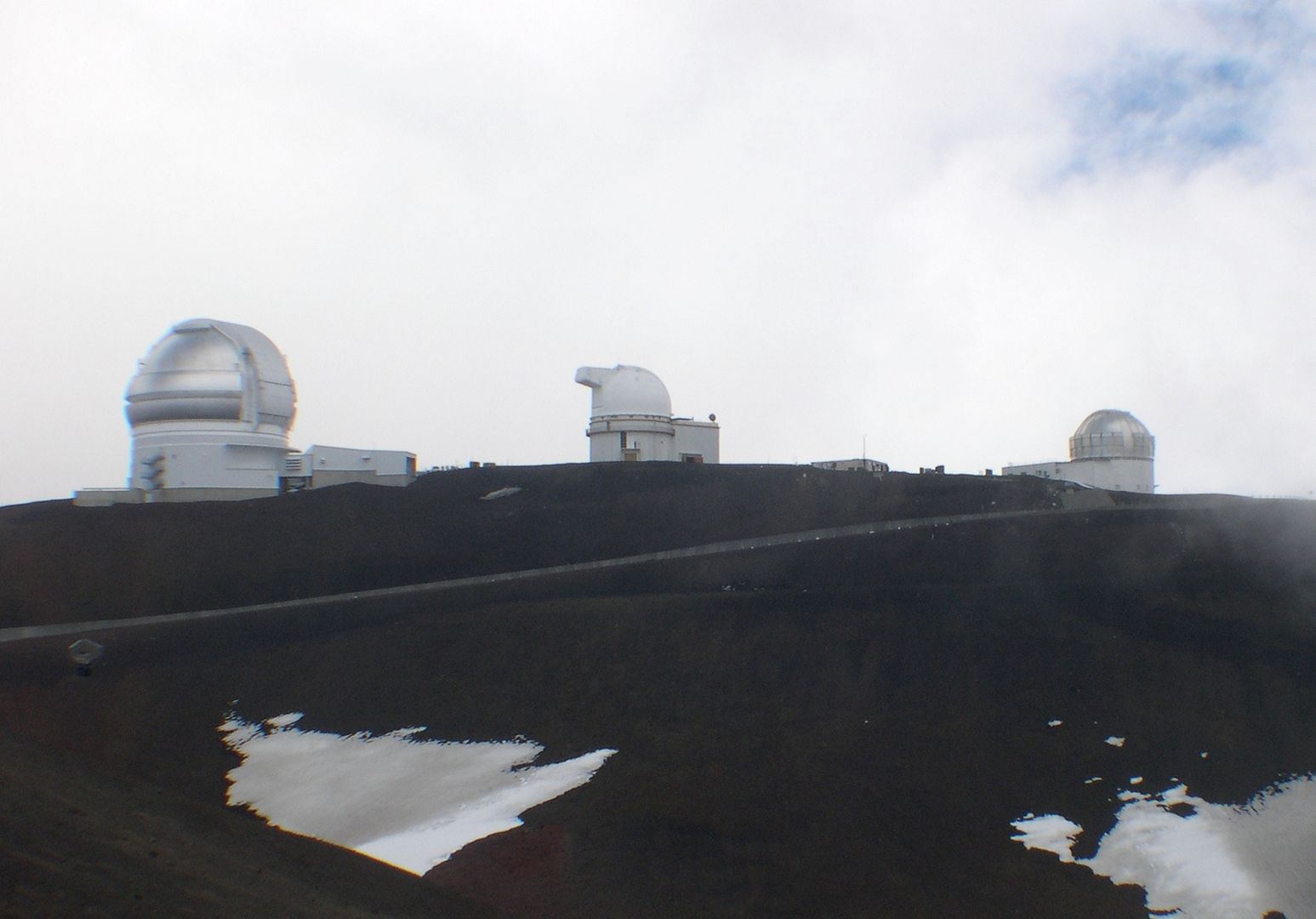 |
| Gemini, 2.2-meter University of Hawaii Telescope, and the United Kingdom Ifrared Telescope (UKIRT) |
Before I left the mountaintop I also had a distant view of the Submillimeter Array:
Finally, while I was in Hawai'i I also had the opportunity to present at AstroDay in Hilo, a major astronomy public outreach event.
I surprised more than a few people there by representing an observatory from the mainland. Curiously, I was set up right next to a booth for the International Dark-Sky Association where I now work.
This year's AstroDay will be held on May 3rd. Here's a Facebook page that describes this year's event. If you are going to be on the Big Island that day, you should make plans to attend.
If you can't make the visit to Mauna Kea, I encourage you to explore the links I placed in this post. You might also be interested in seeing some of the many webcams that are on the mountain. When the daytime weather is nice there are great views of the various domes. At night there can also be some great views of the night sky from the CFHT Cloudcam.
I hope you've enjoyed this quick look at some of the best astronomical telescopes in the world. I still have a few more observatories to share as a part of my Telescope Tourist posts. Hopefully, I'll have the time to post more of them soon.
Subscribe to:
Posts (Atom)
